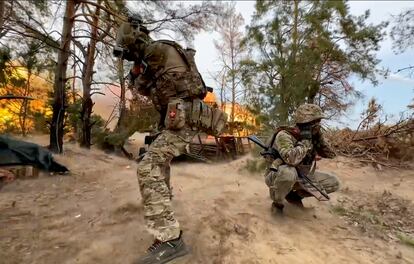The battle Russia has not yet fought: The mental health of its war veterans
Hundreds of thousands of troops are at risk of suffering from post-traumatic stress disorder when they return from the front and the Kremlin has no support network in place


Whatever the outcome of the war in Ukraine, hundreds of thousands of Russian combatants will be plagued by post-traumatic stress disorder (PTSD) for the rest of their lives. Depression, suicide, alcoholism, and violence are some of the consequences of the same illness that marked the United States after the Vietnam War. Russian Deputy Defense Minister Anna Tsivileva has said that PTSD already affects 20% of Russian veterans returning from the front in Ukraine. Clinical studies say that the number of people who suffer from this disorder across all conflicts is between 25% and 50%. Unlike the United States, Russia does not yet have an extensive support network to help former soldiers throughout their lives, despite the fact that the invasion of Ukraine is now the country’s deadliest conflict since World War II.
The Russian government is hiding statistics that could provide an idea of the social problem it will face in the coming decades. According to the World Health Organization (WHO), Russia ranked ninth in the world for suicides in 2019, with 25.1 deaths per 100,000 inhabitants — rising to 44 among the male population. But this figure predates the years of the pandemic and the war in Ukraine.
“Any war leads to suicide. Absolutely any. We will undoubtedly have enormous problems,” Colonel Andrei Demurenko reflects in a quiet coffee shop in the center of Moscow. “Both on the Ukrainian side and on our side there will be a large number of people out of normality, people who will have no control over themselves, who will not be able to work, have a partner or children. Their life will be completely different after fighting. I know that well.
Demurenko, 68, has vast military experience. He was a commander in the international peacekeeping forces in Bosnia (1992-1995) and last year joined the Russian forces as first deputy commander of the Wolf volunteer brigade, led by a Serbian officer. Because of his experience and language skills, the colonel had de facto command of about 1,800 men to protect one of the Wagner mercenary group’s flanks during the Battle of Bakhmut. He arrived in March 2023 and in May was wounded in the head by artillery fire during a reconnaissance mission. He suffered a hematoma and skull fractures, and his hands still shake. He wants to return to Ukraine, but the doctors won’t pass him as fit to go.
“I have met many who marched to the front. Brigades of volunteers and recruits. They said they were ready to die, but I told them that’s not the worst thing. If you die, that’s it. The most complicated thing is that you don’t know how difficult it is to return to normal life,” Demurenko says.
PTSD
Post-traumatic stress disorder was internationally recognized as a mental health problem in 1980 thanks to Vietnam War veterans. Today, U.S. authorities spend billions of dollars supporting former combatants and have a network of 120 centers to care for them, but still around 30,000 veterans took their own lives between 2001 and 2019 — a number four times greater than all U.S. military personnel killed in combat in Afghanistan and Iraq. And the real number could be even three times higher, according to a study by the University of Alabama.
Russia does not have these resources, even though current recruitment brochures guarantee psychological care for soldiers. However, steps are being taken to reverse this. Last year, Russian President Vladimir Putin approved the creation of the Defenders of the Fatherland fund, with an allocation of 1.8 billion roubles (around $200 million) that includes not only psychological support, but medical, social, and employment assistance, such as education and training in new jobs, for veterans and their families.
Among other measures, Moscow announced in 2023 the creation of a program limited to the “detection” and “prevention” of PTSD at the front, which would consist of a temporary “basic treatment” in the rear before returning to combat. It was originally aimed at officers, although it was finally decided to extend it to all ranks. Meanwhile, the Higher School of Economics and the Psychological Assistance Center of the Ministry of Emergencies, headed by the daughter of former Defense Minister Sergei Shoigu, last year advanced a one-week training program for psychiatrists focused on PTSD.
“The Russian Ministry of Defense initially did not pay enough attention to PTSD and focused mainly on physical injuries,” says Ruslan Pukhov, director of the think tank Centre for Analysis of Strategies and Technologies (CAST), by telephone. “But over time it has understood the importance of solving this problem. Ukraine syndrome will be a much bigger phenomenon than the Chechen syndrome (1994-1996 and 1999) or the Afghan syndrome (1979-1989). It will be comparable in scale to the Vietnam syndrome in the United States and will last for many years.”
Hundreds of thousands of Russians will one day return from the war. Putin estimated in December 2023 that 617,000 combatants were fighting on the Russian side. To these should be added those who have been killed or wounded, but the Kremlin is not revealing the scale of the tragedy. A leak from U.S. intelligence published by The Economist put the number of Russian casualties in June of this year at between 462,000 and 728,000 dead and wounded.
“The war in Yugoslavia was a low-intensity conflict,” Demurenko says. “The war in Ukraine is completely different, it is very cruel. Huge masses of people clash at close range with small arms and artillery firing all the time. You are surrounded by tanks and drones.” Demurenko describes the current conflict, which has even frightened battle-hardened Serbian volunteers: “On TV it looks like it is a normal war, that everything is clean, the trenches are full of boards and there is a field kitchen and sleeping bags. Don’t believe it.” As the colonel relates, soldiers live in liquid mud, stomachs suffer from being fed the same canned food every day, and there is no rotation. “We only carry water to drink. To wash ourselves, we resort to puddles, and even urine.”
People are eating leisurely breakfasts in the cafeteria. Nearby there is a terrace where hundreds of young people danced, drank, and flirted during the summer. It is another world compared to the barbarism that can only be seen in Moscow by videos leaked to the internet: soldiers who take their own lives with the barrel of a gun in their mouths in front of the drone that records them; troops who have caught a sniper — the most feared and hated enemy — and behead him.
“There is no mercy or pity for enemies,” Demurenko says. “After that, you can’t be normal anymore. And there are worse things: when you are forced to kill someone at point-blank range, when suddenly your comrade is killed by a shot in the head, or an explosion rips off his leg,” he says before citing another example that came to him from reliable sources: a convict promised his commander 10 Ukrainian ears. “He delivered them and then asked for a pardon for having gone to war.”
The invasion of Ukraine has divided Russian society between those who have gone to the front and those who have remained at home. In addition, wages are equalizing due to the country’s inflationary spiral. “The veteran who has lost his head will tomorrow see those who stood idly by [...] and ask ‘what about us?’ There will be trouble,” the colonel warns.
The return to routine will be another shock for veterans if they are not reintegrated. “Money and patriotism have been secondary motives for enlisting,” Demurenko says. “Many have gone for recognition, to be able to think they haven’t lived their life in vain, a small guy from a small town who never did anything.”
A difficult return to reality
Psychiatrist Pau Pérez-Sales, director of the SIRA Centre for the Care of Victims of Torture, emphasizes in a telephone conversation that PTSD “is the body’s biological response to all this horror, but it is not all that war leaves behind. There is a much deeper, more existential part,” the expert points out. “Sertraline and paroxetine [two antidepressants] give you a certain calm, but self-analysis — questions like ‘what did I do with my life’ or ‘why did I kill that person’ — no drug will take that away.”
The psychiatrist worked for decades in Latin America and sees a possible similarity with Russia. “In Honduras and El Salvador, there was a spectacular upturn in crime after the peace accords. Many people from the guerrilla organizations and the army suddenly became unemployed and resorted to common crime.”
Irene de la Vega, a specialist of the Spanish Society of Clinical Psychology-ANPIR, explains by telephone that PTSD “is different in each person, but almost all psychological therapies include exposure to stimuli that can trigger traumatic memories.” The objective, according to the expert, is “to reprocess that experience in order to integrate it into the memory so that it remains as a bad memory that is not always present, and not as a memory that you are experiencing over and over again.”
Medication can be a complement to therapy, but it is the first line of defense against the disorder. Symptoms include loss of self-control, which can lead to violent behavior, and dissociation. “It’s like being in a dream, in a movie. Putting toothpaste on your toothbrush seems absurd,” adds De la Vega.
Sign up for our weekly newsletter to get more English-language news coverage from EL PAÍS USA Edition
Tu suscripción se está usando en otro dispositivo
¿Quieres añadir otro usuario a tu suscripción?
Si continúas leyendo en este dispositivo, no se podrá leer en el otro.
FlechaTu suscripción se está usando en otro dispositivo y solo puedes acceder a EL PAÍS desde un dispositivo a la vez.
Si quieres compartir tu cuenta, cambia tu suscripción a la modalidad Premium, así podrás añadir otro usuario. Cada uno accederá con su propia cuenta de email, lo que os permitirá personalizar vuestra experiencia en EL PAÍS.
¿Tienes una suscripción de empresa? Accede aquí para contratar más cuentas.
En el caso de no saber quién está usando tu cuenta, te recomendamos cambiar tu contraseña aquí.
Si decides continuar compartiendo tu cuenta, este mensaje se mostrará en tu dispositivo y en el de la otra persona que está usando tu cuenta de forma indefinida, afectando a tu experiencia de lectura. Puedes consultar aquí los términos y condiciones de la suscripción digital.
More information
The journey of thousands of young Ukrainian deserters: Tight border controls and perilous mountains
Archived In
Últimas noticias
Maduro pleads not guilty before the federal court in New York: ‘I am still the president of Venezuela’
A new test can detect Alzheimer’s from a finger prick
UN team enters Sudanese city of El Fasher after paramilitary massacre: ‘It’s like a ghost town’
A recipe for resistance: Indigenous peoples politicize their struggles from the kitchen
Most viewed
- Gilles Lipovetsky: ‘If you want to live better and fall in love, take Prozac, don’t look to philosophy’
- Alain Aspect, Nobel laureate in physics: ‘Einstein was so smart that he would have had to recognize quantum entanglement’
- Alvin Hellerstein, a 92-year-old judge appointed by Bill Clinton, to preside over Maduro’s trial in New York
- Why oil has been at the center of Venezuela-US conflicts for decades
- Maduro’s downfall puts China’s relationship with Venezuela to the test









































